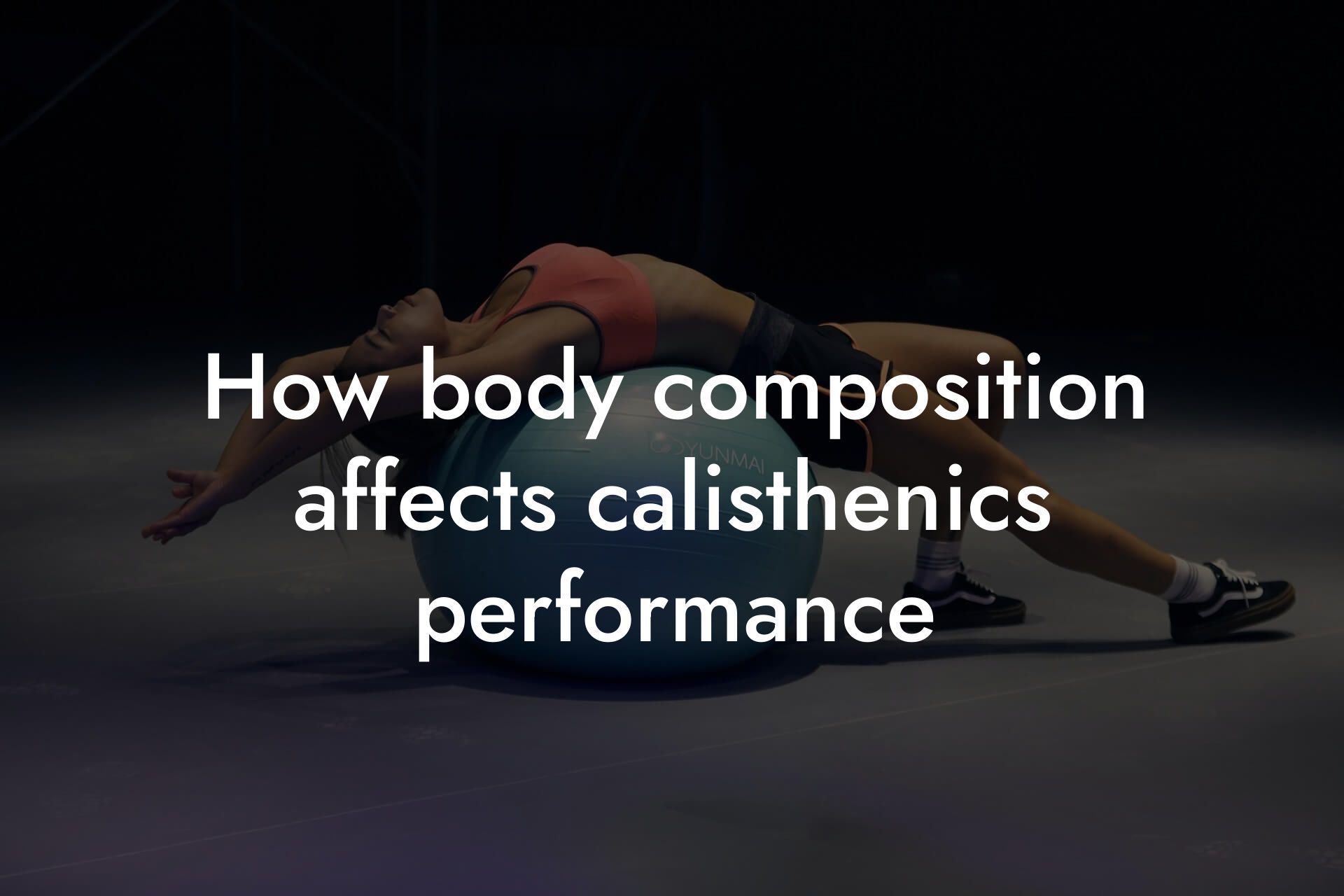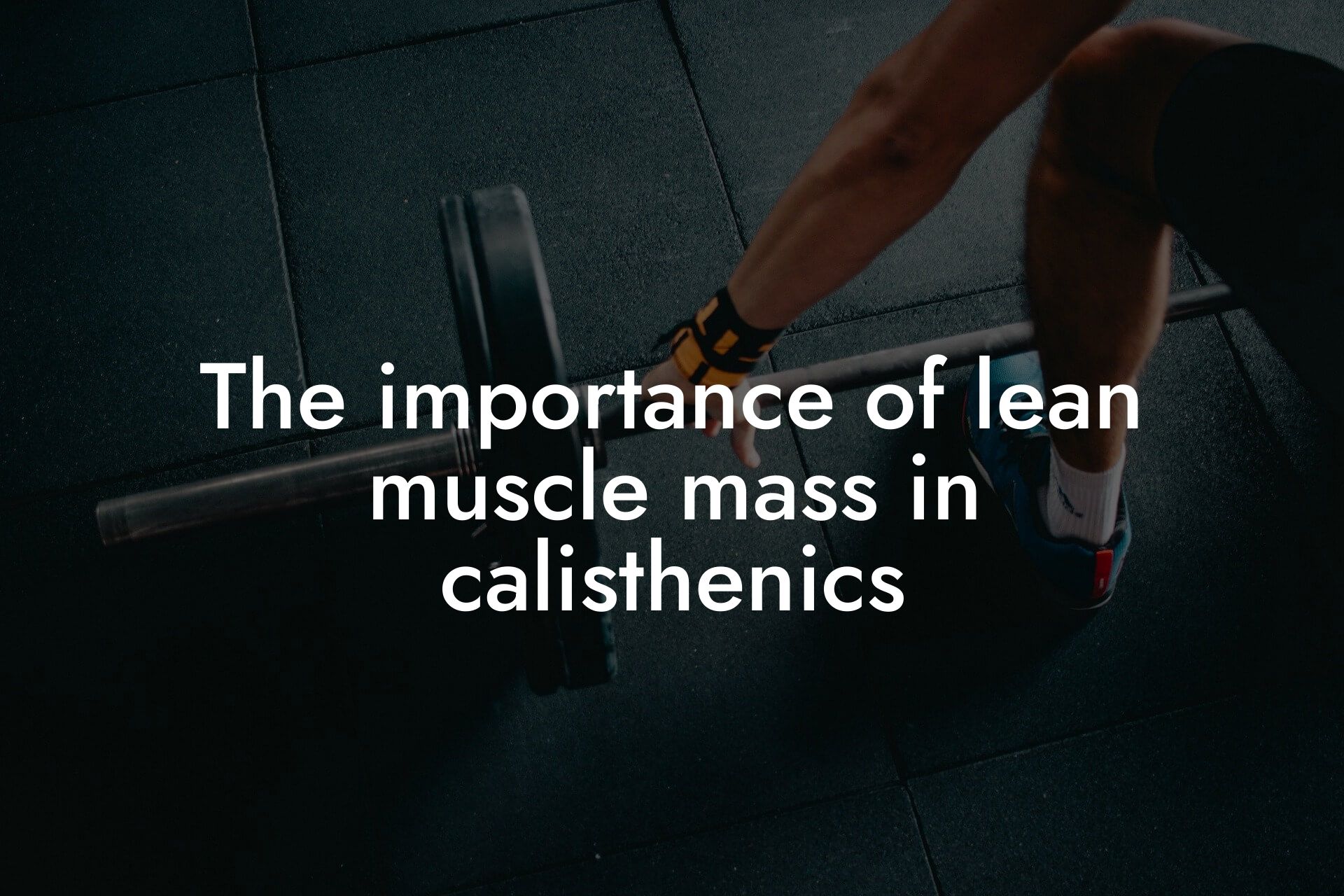As a high-earning professional, you understand the importance of maintaining a strong and healthy physique. Not only does it boost your confidence, but it also enhances your overall well-being and energy levels. At Tano Performance Group, we believe that building functional strength is a crucial aspect of achieving your fitness goals. In this article, we'll delve into the world of calisthenics and provide you with a comprehensive guide on how to build functional strength using bodyweight exercises.
Table of Contents
What is Functional Strength?
Functional strength refers to the strength and power that enables you to perform daily tasks and activities with ease and efficiency. It's the ability to move your body in a way that's natural and effective, without relying on machines or weights. Functional strength is essential for maintaining good posture, preventing injuries, and improving overall athletic performance.
Why Calisthenics?
Calisthenics is a form of exercise that uses your body weight as resistance to build strength and improve flexibility. It's an excellent way to build functional strength because it mimics the movements and actions you perform in everyday life. Calisthenics exercises are often compound movements that engage multiple muscle groups simultaneously, making them an efficient and effective way to work out. Additionally, calisthenics exercises can be modified to suit different fitness levels, making them accessible to everyone.
Benefits of Building Functional Strength with Calisthenics
Building functional strength with calisthenics offers numerous benefits, including:
Improved overall strength and power
Enhanced athletic performance
Increased flexibility and mobility
Better posture and reduced risk of injury
Improved bone density
Increased metabolism and weight loss
Reduced risk of chronic diseases, such as heart disease and diabetes
Essential Calisthenics Exercises for Building Functional Strength
To build functional strength with calisthenics, it's essential to focus on exercises that work multiple muscle groups simultaneously. Here are some essential exercises to include in your workout routine:
Squats: Works the legs, glutes, and core muscles
Push-ups: Works the chest, shoulders, and triceps
Lunges: Works the legs, glutes, and core muscles
Planks: Works the core muscles and improves posture
Pull-ups: Works the back, shoulders, and arms
Dips (using a chair or bench): Works the triceps and chest
Burpees: Works the entire body, including the legs, core, and upper body
Creating a Calisthenics Workout Routine
To build functional strength with calisthenics, it's essential to create a workout routine that's challenging, yet manageable. Here are some tips to help you create an effective routine:
Start with 2-3 times per week, with at least one day of rest in between
Begin with lower reps and sets, and gradually increase as you build strength and endurance
Focus on compound exercises that work multiple muscle groups simultaneously
Incorporate a mix of upper body, lower body, and core exercises
Include exercises that target different planes of motion, such as sagittal, frontal, and transverse
Make sure to warm up before each workout, and cool down afterwards
Progressive Overload and Periodization
To continue making progress and building functional strength, it's essential to incorporate progressive overload and periodization into your workout routine. Progressive overload involves gradually increasing the intensity of your workouts by adding more reps, sets, or weight. Periodization involves varying the intensity and volume of your workouts over time to avoid plateaus and prevent overtraining.
Common Mistakes to Avoid
When building functional strength with calisthenics, it's essential to avoid common mistakes that can lead to injury or plateaus. Here are some common mistakes to avoid:
Not warming up or cooling down properly
Not focusing on proper form and technique
Not incorporating progressive overload and periodization
Not listening to your body and taking rest days when needed
Not varying your workout routine and incorporating new exercises
Building functional strength with calisthenics is a powerful way to improve your overall fitness and well-being. By incorporating the exercises and tips outlined in this article, you'll be well on your way to achieving your fitness goals. Remember to always focus on proper form and technique, and to listen to your body and take rest days when needed. With consistency and patience, you'll be able to build the functional strength and physique you've always wanted.
At Tano Performance Group, we're committed to helping high-earning professionals like you achieve their fitness goals. Our DEXA machine provides a comprehensive body assessment, giving you the information you need to take your fitness to the next level. Contact us today to learn more about our services and how we can help you achieve your goals.
Frequently Asked Questions
What is functional strength, and why is it important?
Functional strength refers to the strength and ability to perform daily tasks and movements with ease and efficiency. It's essential for high-earning professionals like yourself because it can improve overall physical appearance, increase energy levels, and enhance overall well-being. Functional strength training with calisthenics can help you build strength that translates to real-life movements, making everyday activities easier and reducing the risk of injury.
What are calisthenics, and how do they differ from traditional weightlifting?
Calisthenics are a form of exercise that uses bodyweight as resistance to build strength and improve flexibility. Unlike traditional weightlifting, calisthenics focus on functional movements that work multiple muscle groups at once, rather than isolating individual muscles. This approach helps improve overall strength, coordination, and balance, making it an excellent choice for building functional strength.
Do I need to have a gym membership to start building functional strength with calisthenics?
Absolutely not! One of the best things about calisthenics is that you can do them anywhere, anytime, without any equipment or gym membership. You can start building functional strength in the comfort of your own home, office, or even outdoors.
What are some examples of calisthenic exercises that can help build functional strength?
Some examples of calisthenic exercises that can help build functional strength include push-ups, squats, lunges, planks, dips, burpees, and mountain climbers. These exercises work multiple muscle groups at once, improving overall strength, flexibility, and coordination.
How do I know if I'm doing calisthenic exercises correctly?
Proper form and technique are crucial when performing calisthenic exercises. Make sure to start with lower reps and sets and gradually increase as you build strength and confidence. Focus on controlled movements, engage your core, and avoid arching your back or using momentum. If you're new to calisthenics, consider working with a personal trainer or fitness coach to help you develop proper form and technique.
Can I build functional strength with calisthenics if I'm a beginner?
Absolutely! Calisthenics are an excellent choice for beginners because they can be modified to suit different fitness levels. Start with lower reps and sets, and gradually increase as you build strength and confidence. You can also modify exercises to make them easier or more challenging, depending on your fitness level.
How often should I do calisthenic exercises to build functional strength?
Aim to do calisthenic exercises 2-3 times per week, with at least one day of rest in between. This will give your muscles time to recover and rebuild, which is essential for building functional strength. As you get stronger, you can gradually increase the frequency and intensity of your workouts.
Can I build functional strength with calisthenics if I have a busy schedule?
Yes, you can! Calisthenic exercises can be done in short bursts, even with a busy schedule. Try doing 10-15 minute workouts during your lunch break, or fit in a quick 20-minute workout before bed. Consistency is key, so even small amounts of exercise can add up to make a big difference in your functional strength.
Will building functional strength with calisthenics help me lose weight?
Yes, building functional strength with calisthenics can help you lose weight and improve overall body composition. As you build muscle mass, your metabolism will increase, helping you burn more calories at rest. Additionally, calisthenic exercises can help improve insulin sensitivity, reducing the risk of chronic diseases like diabetes and heart disease.
Can I build functional strength with calisthenics if I have a desk job?
Absolutely! Desk jobs can be notorious for causing sedentary behavior, but calisthenic exercises can help combat this. Try doing desk exercises like chair squats, desk push-ups, and leg raises to get your blood flowing and build functional strength, even at work.
How does building functional strength with calisthenics improve bone density?
Building functional strength with calisthenics can help improve bone density by stimulating osteogenesis, the process by which new bone tissue is formed. This is especially important for high-earning professionals like yourself, as strong bones can reduce the risk of osteoporosis and fractures later in life.
Can I build functional strength with calisthenics if I'm over 40?
Absolutely! Calisthenic exercises are an excellent choice for anyone, regardless of age. As we age, our muscle mass and bone density naturally decline, but building functional strength with calisthenics can help combat this. Start with lower reps and sets, and gradually increase as you build strength and confidence.
How does building functional strength with calisthenics improve overall physique?
Building functional strength with calisthenics can help improve overall physique by increasing muscle mass, reducing body fat, and improving posture. As you build strength, you'll notice improvements in your overall shape and tone, making you look and feel more confident and energetic.
Can I build functional strength with calisthenics if I have a injury or chronic condition?
It's essential to consult with a healthcare professional or fitness coach before starting any new exercise program, especially if you have an injury or chronic condition. They can help you modify exercises to suit your needs and abilities, ensuring you build functional strength safely and effectively.
How does building functional strength with calisthenics improve mental health?
Building functional strength with calisthenics can have a profound impact on mental health by reducing stress and anxiety, improving mood, and increasing self-confidence. Exercise has been shown to stimulate the release of endorphins, also known as "feel-good" hormones, which can help improve overall mental well-being.
Can I build functional strength with calisthenics if I'm not flexible?
Absolutely! Calisthenic exercises can help improve flexibility and range of motion, even if you're not naturally flexible. Start with lower reps and sets, and gradually increase as you build strength and flexibility. You can also incorporate stretching exercises into your routine to improve flexibility and reduce the risk of injury.
How does building functional strength with calisthenics improve athletic performance?
Building functional strength with calisthenics can improve athletic performance by increasing power, speed, and agility. Calisthenic exercises can help improve coordination, balance, and overall athleticism, making you a better performer in your chosen sport or activity.
Can I build functional strength with calisthenics if I'm a woman?
Absolutely! Calisthenic exercises are an excellent choice for women, as they can help improve overall strength, flexibility, and bone density. Women can benefit from building functional strength with calisthenics, especially during pregnancy and menopause, when hormone changes can affect bone density and overall health.
How does building functional strength with calisthenics improve overall health?
Building functional strength with calisthenics can have a profound impact on overall health by reducing the risk of chronic diseases, improving insulin sensitivity, and increasing overall physical function. Calisthenic exercises can also help improve sleep quality, reduce stress and anxiety, and increase energy levels, making you feel more confident and energetic.
Can I build functional strength with calisthenics if I'm a beginner to fitness?
Absolutely! Calisthenic exercises are an excellent choice for beginners to fitness, as they can be modified to suit different fitness levels. Start with lower reps and sets, and gradually increase as you build strength and confidence. You can also work with a personal trainer or fitness coach to help you develop a customized workout plan.
How does building functional strength with calisthenics improve self-confidence?
Building functional strength with calisthenics can have a profound impact on self-confidence by improving overall physical appearance, increasing energy levels, and enhancing overall physical function. As you build strength and confidence, you'll notice improvements in your overall self-esteem, making you feel more confident and empowered.
Can I build functional strength with calisthenics if I have a physical limitation?
It's essential to consult with a healthcare professional or fitness coach before starting any new exercise program, especially if you have a physical limitation. They can help you modify exercises to suit your needs and abilities, ensuring you build functional strength safely and effectively.
How does building functional strength with calisthenics improve overall quality of life?
Building functional strength with calisthenics can have a profound impact on overall quality of life by improving physical function, reducing the risk of chronic diseases, and increasing overall energy levels. As you build strength and confidence, you'll notice improvements in your overall quality of life, making you feel more confident, energetic, and empowered.
Here are some related articles you might love...
- Using DEXA scans to monitor progress in calisthenics
- How body composition affects calisthenics performance
- The importance of lean muscle mass in calisthenics
- Preventing injuries in calisthenics: A comprehensive guide
- Strength and conditioning programs for calisthenics practitioners
- Reducing body fat for improved strength-to-weight ratio in calisthenics
- Nutrition tips for calisthenics athletes
- Recovery strategies for calisthenics athletes
- Bone density and its role in calisthenics training
Zak Faulkner
Zak Faulkner is a leading authority in the realm of physical health and body composition analysis, with over 15 years of experience helping professionals optimise their fitness and well-being. As one the experts behind Tano Performance Group, Zak has dedicated his career to providing in-depth, science-backed insights that empower clients to elevate their physical performance and overall health.
With extensive knowledge of DEXA technology, Zak specializes in delivering comprehensive body assessments that offer precise data on body fat, muscle mass, bone density, and overall physique. His expertise enables individuals to make informed decisions and achieve their fitness goals with accuracy and confidence. Zak’s approach is rooted in a deep understanding of human physiology, combined with a passion for helping clients unlock their full potential through personalised strategies.
Over the years, Zak has earned a reputation for his commitment to excellence, precision, and client-focused service. His guidance is trusted by top professionals who demand the best when it comes to their health. Whether advising on fitness programs, nutritional strategies, or long-term wellness plans, Zak Faulkner’s insights are a valuable resource for anyone serious about taking their health and fitness to the next level.
At Tano Performance Group, Zak continues to lead our Content Team revolutionising how professionals approach their physical health, offering unparalleled expertise that drives real results.




